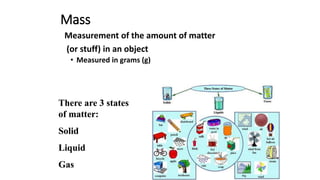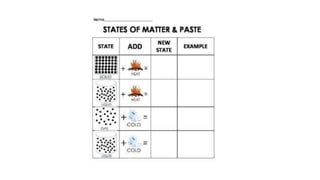Unit 4. natural sciences.
- 1. TEACHER: MARCOS RODRÍGUEZ UCEDO 5º PRIMARY
- 2. What is matter? Matter is anything that has mass and takes up space.
- 3. SOLIDS
- 4. SOLID A solid is matter that has that has definite size and shape. Example: Put a sneaker in a box. It stays the same.
- 5. Liquids
- 6. LIQUID A liquid takes the shape of any container. Example: Pour juice into a glass. The juice will take on the shape of the glass.
- 7. GAS
- 8. Gas Gas is matter that has no definite shape. Gases take the shape of whatever container they are in . Example: The air all around us is a gas.
- 10. Mass Measurement of the amount of matter (or stuff) in an object • Measured in grams (g) There are 3 states of matter: Solid Liquid Gas There are 3 states of matter: Solid Liquid Gas
- 11. Volume Measurement of the amount of space an object takes up • Measured in milliliters (ml) o litre (l)
- 12. Which do you think would have the greater volume? The greater mass? Why? 1 kg of feathers 1 kg of rocks
- 13. Properties of matter • HARDNESS • FRAGILITY • ELASTICITY • DENSITY
- 14. Density is defined as mass per unit volume. It is a measure of how tightly packed and how heavy the molecules are in an object. Density is the amount of matter within a certain volume. Density
- 17. JOURNAL • What are you doing now? • What are you learning?
















